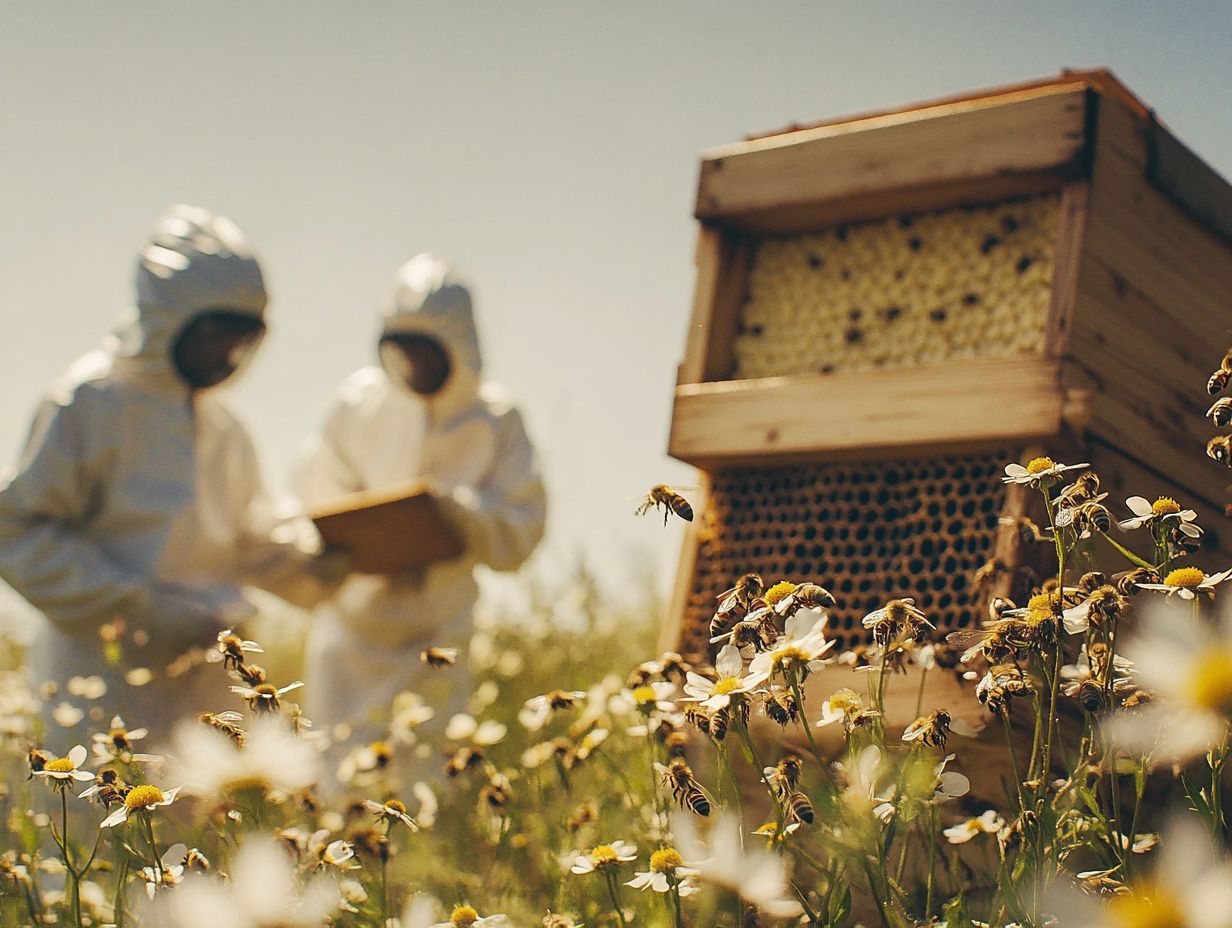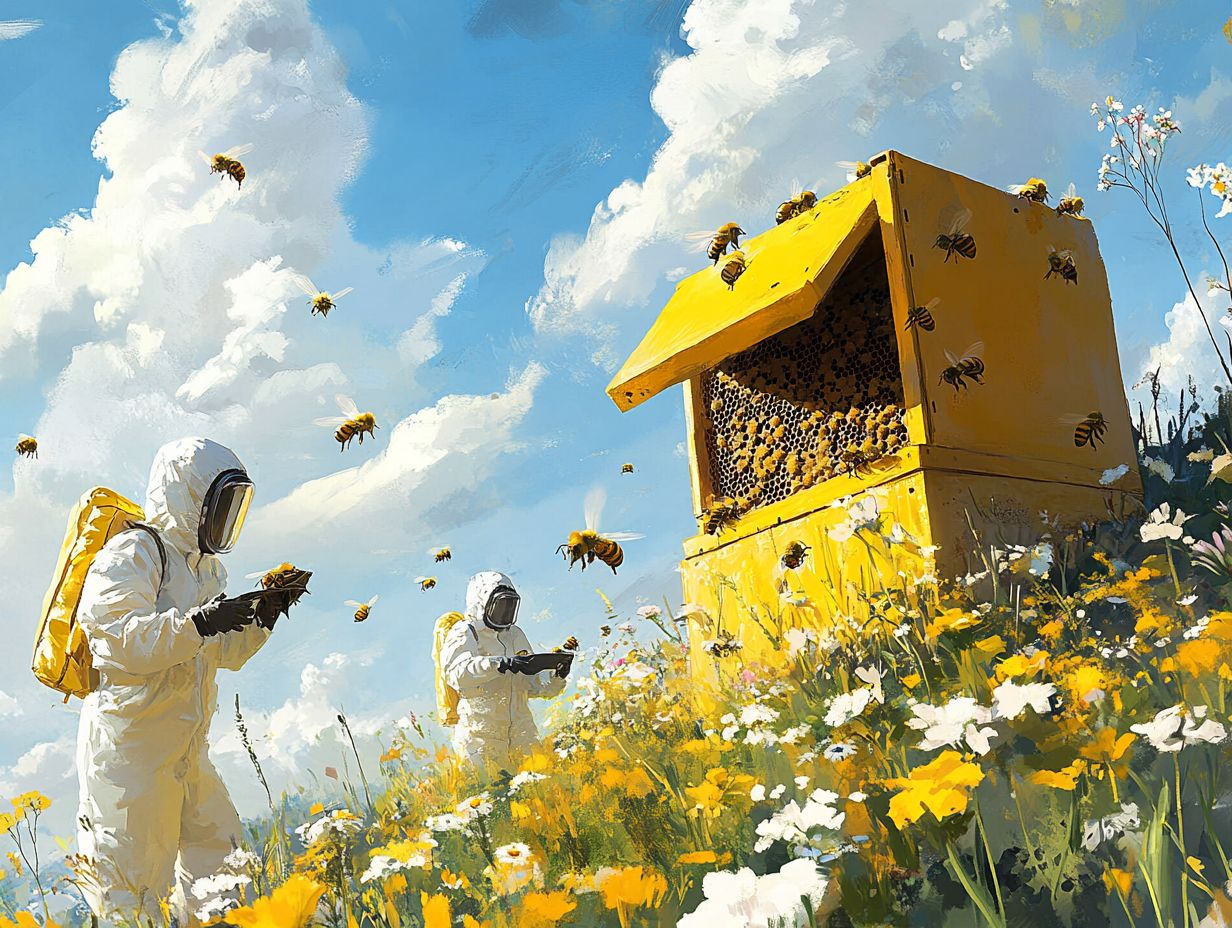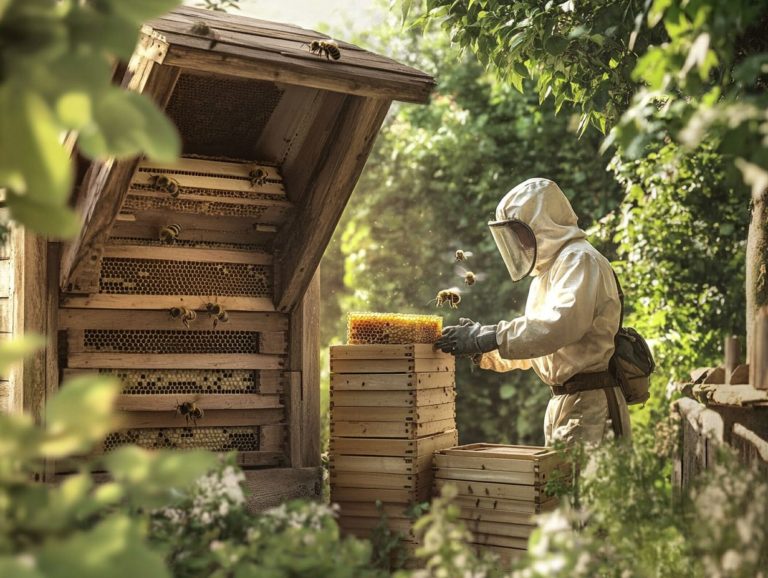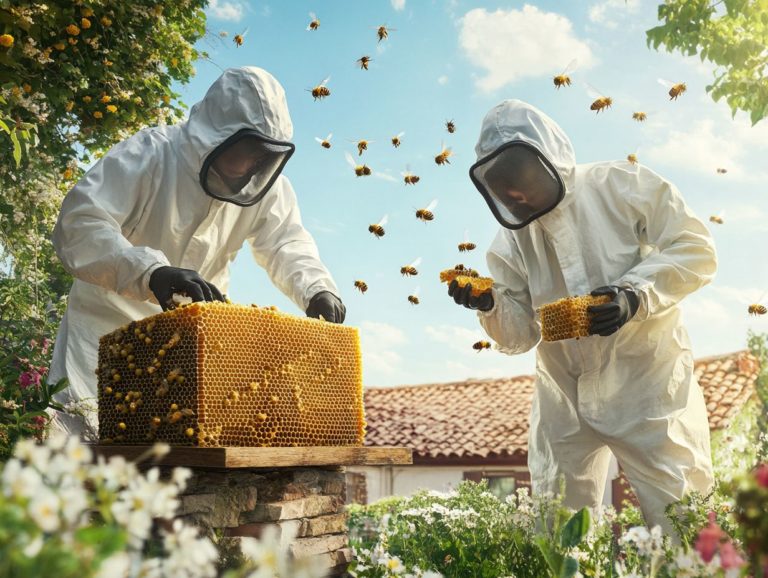Improving Hive Productivity with Management
Hive management stands as a cornerstone of beekeeping, significantly influencing the health and productivity of your bee colonies through strategic planning and resource management.
Mastering effective hive management can transform your beekeeping experience! By understanding the principles of effective hive management, you can cultivate thriving environments that benefit your bees immensely. This article delves into the essential components of hive management, covering everything from optimal location and seasonal considerations to tackling common challenges like pests and diseases. Project managers often utilize customizable workflows to streamline these processes.
This article presents practical strategies to enhance hive productivity, ensuring that you can nurture healthy, flourishing colonies. Discover the key factors that contribute to successful hive management, such as time tracking and task assignment, and learn how to navigate the potential hurdles you may encounter on your beekeeping journey.
Contents
- Key Takeaways:
- What is Hive Management?
- Why is Hive Management Important?
- What are the Key Factors for Successful Hive Management?
- What are the Common Challenges in Hive Management?
- How to Improve Hive Productivity with Management?
- Optimizing Team Efficiency and Collaboration
- Frequently Asked Questions
- What is hive productivity and why is it important to manage it?
- How can I improve hive productivity with management?
- What are some common management practices that can help improve hive productivity?
- How often should I inspect my hive to improve productivity?
- Do I need to use any special tools or equipment to manage hive productivity?
- Are there any natural methods for improving hive productivity?
Key Takeaways:

- Take charge of your hive management to ensure healthy, productive bee colonies.
- Factors such as location, beekeeper knowledge, and seasonal considerations greatly impact the success of hive management.
- Regular inspections, proper food and water supply, and controlling pests and diseases are key to improving hive productivity with effective task management.
What is Hive Management?
Hive management embodies a sophisticated approach to overseeing and organizing your beekeeping activities. It seamlessly integrates project management, team collaboration, and task management to elevate your efficiency and productivity.
This method encompasses essential aspects like time tracking, managing resources, and analytics, all aimed at ensuring effective operations in your beekeeping endeavors.
With the rise of cloud-based software, hive management enables you to streamline processes, manage tasks with precision, and foster enhanced collaboration among your team members. Integration with tools like Slack, Google Drive, and Zapier further enhances team efficiency.
Why is Hive Management Important?
Effective hive management is essential, as it plays a crucial role in the success of your projects. It ensures that tasks are carried out efficiently, fostering enhanced collaboration among your team and boosting overall productivity.
By utilizing efficient task management strategies, including project views and progress tracking, you can gain valuable performance insights that enable you to make informed, data-driven decisions. These decisions will not only positively impact the health of your hives but will also significantly enhance their productivity.
What are the Benefits of Proper Hive Management?
Engaging in proper hive management presents you with a wealth of benefits, chief among them being enhanced task management that translates into increased productivity and improved project outcomes in your beekeeping operations. By cultivating team collaboration and leveraging performance insights, you can fine-tune your management strategies, ensuring the health and productivity of your hives.
- Systematic monitoring of hive conditions can dramatically elevate bee health, allowing for swift responses to potential threats like diseases or pests.
- Regular inspections pinpoint colony stressors and enable you to manage resources with greater efficiency.
- Utilizing tools like hive scales offers you real-time data on weight fluctuations, helping you assess honey stores effectively.
- Implementing a rotation schedule for hive positions can significantly boost foraging efficiency.
- Establishing a clear communication plan among your team members ensures everyone stays informed and engaged, minimizing the risk of oversights and fostering a proactive approach to hive management.
Altogether, these strategies contribute to a more resilient and productive beekeeping operation.
What are the Key Factors for Successful Hive Management?
Successful hive management relies on key factors, such as effective time tracking, team collaboration, and efficient task completion. Each of these elements is crucial for maintaining the productivity and health of your hive.
By prioritizing these aspects, you can ensure that your hives thrive and your operations flourish.
1. Location of the Hive
The location of your hive is a pivotal aspect of hive management. It influences resource availability and the environmental conditions crucial for the health of your bee colonies.
Selecting the perfect spot for your hive requires more than just convenience. It demands a good understanding of how the surrounding flora and fauna affect bee activity and sustainability.
Consider factors such as proximity to nectar sources, access to water, and protection from harsh weather. These play significant roles in the well-being of your hive.
When evaluating potential sites, you can also use project management principles to guide your decision-making. Think about accessibility for maintenance, safety from pests, and minimizing disruptions caused by human activities.
By prioritizing these critical aspects, you can enhance hive productivity and create an optimal environment tailored to the needs of your bees. This will help ensure they thrive.
2. Beekeeper Knowledge and Experience
Your knowledge and experience as a beekeeper are essential for effective hive management. They shape how you approach tasks and make critical decisions.
Understanding bee behavior, environmental factors, and pest dynamics allows you to enhance hive health and productivity. Embrace innovative practices and keep up with the latest research to tackle challenges smoothly.
For instance, managing swarming issues and combating diseases can benefit from effective planning, such as using Gantt charts.
Keep learning it’s key to thriving in beekeeping! New techniques and technologies can significantly elevate honey production and the welfare of your bees. This commitment to ongoing education sharpens your practical skills and deepens your connection with the ecosystem.
3. Seasonal Considerations

Seasonal considerations are pivotal in hive management. They guide the timing of various tasks and impact hive productivity.
In spring, activities increase with hive inspections and the addition of new supers. This is when the bees awaken and the queen begins laying eggs with renewed vigor.
Summer demands your attention for continuous monitoring of pests and diseases. Ensure your bees have enough food and space to thrive.
As autumn rolls in, prepare for winter by conducting thorough checks and securing adequate honey reserves. Contemplate mite treatments at this time.
When winter arrives, monitor the hive from a distance to minimize disturbance. By using planning methods, such as scheduling regular inspections and maintaining a flexible task list, you can adapt to seasonal changes effectively.
4. Hive Equipment and Maintenance
Proper hive equipment and maintenance are crucial elements of effective hive management. They enable you to perform essential tasks efficiently throughout the season.
Regular upkeep extends the lifespan of your tools and significantly impacts the health and productivity of your colony. When your equipment is in top shape, you can respond swiftly to the needs of your hives.
This might mean replacing frames or ensuring that entry points are secure. Utilizing a user-friendly interface for tracking maintenance tasks can enhance work efficiency.
Adopt best practices by regularly inspecting your equipment for signs of wear, cleaning surfaces to prevent disease, and sealing any leaks that could allow pests to invade.
This diligence fosters a thriving environment where your bees can work effectively, leading to enhanced honey production and a robust colony.
What are the Common Challenges in Hive Management?
Common challenges in hive management can greatly impede your productivity and affect the overall health of your bee colonies. It s crucial for you as a beekeeper to identify and tackle these issues proactively.
Addressing these challenges now will ensure the well-being of your hives and the success of your beekeeping endeavors. Act now to identify and tackle these challenges to keep your hives thriving!
1. Pests and Diseases
Pests and diseases present significant threats to the health of your hives. It’s crucial to implement effective management strategies to maintain their productivity. Using combined methods to manage pests along with project tracking tools will help you stay ahead of potential issues.
Various pests, such as varroa mites, wax moths, and small hive beetles, can sap the strength of your colonies. Diseases like American foulbrood and nosema can wreak havoc on populations if left unchecked. Regularly inspect your hives for signs of these unwelcome intruders.
Employing integrated pest management that combines mechanical, biological, and chemical controls will serve you well. Fostering hive strength through proper nutrition is also essential for ensuring your bees thrive and flourish.
By taking proactive steps, you can help your bees thrive in the face of challenges. Ultimately, this approach will preserve the longevity and productivity of your apiaries, safeguarding the vital role bees play in our ecosystem.
2. Colony Collapse Disorder
Colony Collapse Disorder (CCD) presents a significant challenge in hive management, impacting bee colonies and leading to substantial productivity losses. Effective resource management and strategic planning is crucial to combat these impacts immediately.
This phenomenon is marked by the sudden and often baffling disappearance of adult bees from a colony, leaving behind a queen, unhatched eggs, and an abundance of honey. The causes of CCD are complex, encompassing factors such as pesticides, habitat loss, diseases, and nutritional deficiencies. This multifaceted nature makes it a formidable obstacle for beekeepers.
The implications of CCD reach far beyond mere hive losses; they pose a threat to agricultural productivity and the delicate balance of our ecosystem, given the vital role bees play in pollination.
To combat this disorder, you can adopt various management strategies, including project management techniques. Emphasizing biodiversity, implementing organic farming practices, and ensuring that your colonies receive adequate nutrition can significantly enhance the resilience of bee populations against these adverse factors.
3. Queen Health and Replacement
Maintaining queen health and understanding the replacement process are crucial elements of hive management. These factors significantly influence the productivity, task management, and efficiency of your colony.
A strong and healthy queen acts as the foundation of a thriving hive, impacting key aspects such as brood production and overall colony morale. Regularly monitor the queen’s behavior through progress tracking. Look for signs of vigor, such as her consistent egg-laying ability and her presence in the brood area.
Implementing management practices, like routine hive inspections and nutritional supplementation, will further bolster queen health. By taking early action in cases of queen failure whether that means introducing a new queen or rearing one from healthy larvae you ensure that your colony remains robust and ready for any challenges. This ultimately enhances honey production and hive resilience.
How to Improve Hive Productivity with Management?

Optimizing Team Efficiency and Collaboration
Enhancing hive productivity through effective management requires engaging in strategic task completion, leveraging performance insights, implementing project views, and adopting best practices to maintain the overall health of the hive.
By taking a thoughtful and informed approach, you can optimize productivity, ensure the vitality of your operation, and realize project success. Start inspecting your hives today!
1. Regular Inspections and Maintenance
Conducting regular inspections and maintenance is essential for ensuring the productivity of your hive. Address potential issues before they escalate into larger problems by using tools like Gantt charts and Kanban boards.
These inspections are vital for monitoring the health of your colony. They enable you to identify early indicators of stress or disease. By consistently checking for symptoms such as abnormal behavior, low honey stores, or the presence of pests, you can take proactive measures to mitigate risks effectively. Utilizing project tracking tools can further streamline this process.
To make the most of your inspections, consider these best practices:
- Schedule inspections during optimal weather conditions for a smoother experience.
- Use gentle handling techniques to minimize disturbance to your bees.
- Document each visit to track changes over time, allowing you to stay ahead of any issues.
Maintaining cleanliness in the hive environment not only promotes better bee health but also enhances overall productivity. This ensures that your colony thrives. Employing automation for routine tasks can make this process more efficient.
2. Providing Adequate Food and Water
Providing adequate food and water is a fundamental aspect of hive management. It directly influences your bees’ health and productivity. Bees depend on a balanced diet, primarily composed of nectar and pollen, to sustain their colonies and maintain hive strength.
To ensure your bees have sufficient food, regularly monitor and assess the resources available within each hive. Use extra food when needed during scarce seasons, ensure diverse forage opportunities, and effectively manage water sources. These actions can significantly enhance a colony’s resilience. Integrating customizable workflows can streamline these tasks.
Maintaining clean water sources and keeping an eye on their availability throughout the year will prevent stress within the colony. This promotes overall well-being and productivity. By proactively managing these resources, you can nurture healthier, more robust bee populations that thrive and contribute positively to their local ecosystems. Effective communication and collaboration tools can assist in this proactive management.
3. Controlling Pests and Diseases
Effective control of pests and diseases is vital for maintaining hive productivity and ensuring the health of your bee colonies.
By implementing a variety of methods, you can proactively manage hive health. Regular inspections are essential, as they enable you to identify early signs of trouble before infestations spiral out of control. Use data to make better decisions.
Utilizing pest control techniques such as combining physical traps with natural treatments can significantly reduce the risk of diseases like Varroa mites, which are harmful parasites that can weaken or destroy a hive. Additionally, maintaining optimal environmental conditions, including proper ventilation and minimizing moisture, will further bolster your bees immune systems. Implementing project templates can aid in structuring these tasks efficiently.
Educating yourself about the various threats and their life cycles will enable you to take timely action, fostering a thriving and productive apiary.
4. Mastering Swarm Management for a Thriving Hive!
Effective swarm management is essential in hive management. It directly impacts the strength, productivity, and overall health of your colony. Leveraging project timelines and task assignments can enhance the effectiveness of your swarm management strategies.
By implementing robust monitoring techniques, you can observe the behavioral patterns and signs that indicate swarming. This allows for timely interventions. Tools like swarm traps, pheromone monitors, and regular hive inspections are invaluable in maintaining a thriving colony environment.
Recognizing when to create splits or add supers can significantly enhance your hive’s productivity and reduce the likelihood of swarming. Efficient swarm management not only boosts the vitality of your colony but also increases honey production, benefiting both you and the ecosystem. Automation can further improve efficiency.
Adopting this holistic approach fosters healthier colonies and ensures sustainability in your beekeeping practices. Act now to keep your hive healthy!
5. Monitoring and Adjusting Hive Population
Team Collaboration and Communication

Monitoring and adjusting hive population is a crucial element of effective hive management. It influences both colony dynamics and overall productivity. Employing task management and project tracking tools can significantly enhance this process.
Effective population management requires more than just counting bees. It demands a deep understanding of the intricate social structure within the hive. You should assess how various factors such as environmental conditions and health issues impact performance. Routinely examine brood patterns, which refers to the stages of bee development within the hive, foraging activity, and the presence of queen cells. Streamlining this process is easier with customizable features and project views.
Implement strategies like swarm prevention and controlled splitting. Adding supplemental bees can improve your hives’ health. Take action now to prevent swarming and boost your hives’ productivity! By taking a proactive approach, you ensure that your colonies not only survive but truly thrive. This leads to increased productivity and contributes to healthier ecosystems. Using cloud-based software for monitoring and adjusting hive population can further enhance efficiency.
For more insights on effective hive management, explore resources from digital project manager forums or cloud-based software solutions like Guru, Slack, Google Drive, Zapier, and Salesforce.
Frequently Asked Questions
What is hive productivity and why is it important to manage it?
Hive productivity refers to the efficiency and output of a bee hive in terms of honey production. It is important to manage hive productivity to ensure healthy and abundant honey production, which is the primary goal of beekeeping.
How can I improve hive productivity with management?
There are various ways to improve hive productivity. Regular hive inspections and providing a suitable environment are key. Additionally, managing pests and diseases, along with proper feeding and nutrition, are essential practices.
What are some common management practices that can help improve hive productivity?
Common management practices include controlling the hive population, reducing swarming, providing adequate ventilation, and maintaining cleanliness in the hive.
How often should I inspect my hive to improve productivity?
It is recommended to inspect your hive at least once a week during the active season and once a month during the inactive season. Regular inspections help identify and address any issues that may affect hive productivity.
Do I need to use any special tools or equipment to manage hive productivity?
While there are various tools and equipment available for beekeeping, the most important aspect is understanding bee behavior and proper beekeeping techniques. Tools like Kanban boards and task assignment can assist in this process.
Are there any natural methods for improving hive productivity?
Yes, some natural methods to improve hive productivity include providing a diverse range of forage sources, using natural pest control methods, and ensuring a clean and healthy environment for the bees. Utilizing project templates and cloud software can aid in planning and executing these methods efficiently.
For further resources and updates on hive management, consider signing up for newsletters or accessing online courses in beekeeping.






